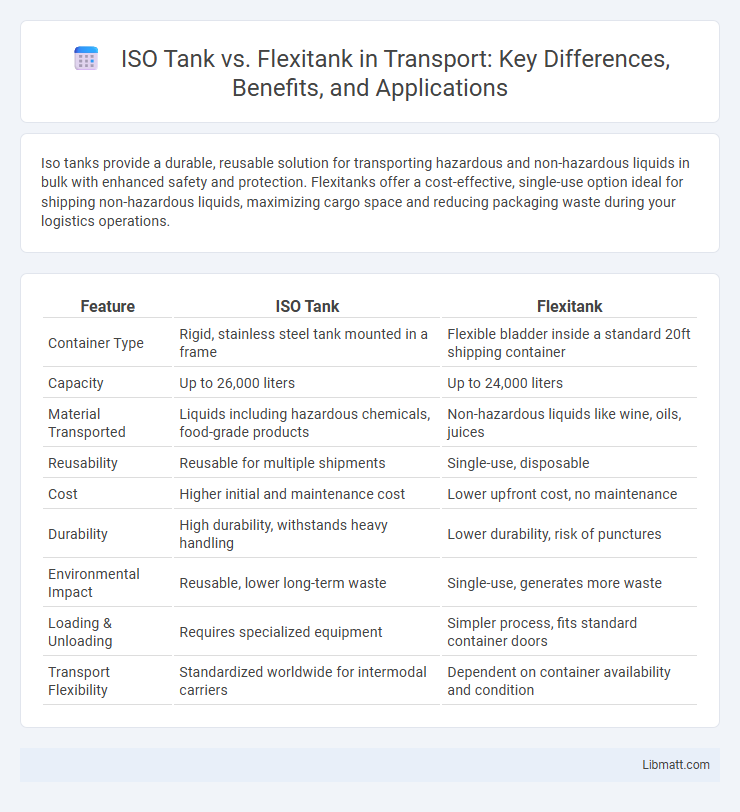Iso tanks provide a durable, reusable solution for transporting hazardous and non-hazardous liquids in bulk with enhanced safety and protection. Flexitanks offer a cost-effective, single-use option ideal for shipping non-hazardous liquids, maximizing cargo space and reducing packaging waste during your logistics operations.
Table of Comparison
| Feature | ISO Tank | Flexitank |
|---|---|---|
| Container Type | Rigid, stainless steel tank mounted in a frame | Flexible bladder inside a standard 20ft shipping container |
| Capacity | Up to 26,000 liters | Up to 24,000 liters |
| Material Transported | Liquids including hazardous chemicals, food-grade products | Non-hazardous liquids like wine, oils, juices |
| Reusability | Reusable for multiple shipments | Single-use, disposable |
| Cost | Higher initial and maintenance cost | Lower upfront cost, no maintenance |
| Durability | High durability, withstands heavy handling | Lower durability, risk of punctures |
| Environmental Impact | Reusable, lower long-term waste | Single-use, generates more waste |
| Loading & Unloading | Requires specialized equipment | Simpler process, fits standard container doors |
| Transport Flexibility | Standardized worldwide for intermodal carriers | Dependent on container availability and condition |
Introduction to ISO Tank and Flexitank
ISO tanks are rigid, reusable containers designed for the safe transportation of bulk liquids, adhering to international standards for durability and safety. Flexitanks are flexible, single-use liners placed inside standard shipping containers to carry non-hazardous liquids in bulk, offering cost-effective and lightweight solutions. Each system caters to different logistical needs, with ISO tanks suited for hazardous or high-value liquids and flexitanks optimized for large volumes of non-hazardous fluids.
What is an ISO Tank?
An ISO tank is a stainless steel container designed for transporting bulk liquids, chemicals, and gases safely and efficiently across long distances. Built to meet International Organization for Standardization (ISO) specifications, this tank ensures durability, standardized dimensions, and compatibility with various transport modes, including sea, rail, and road. Your choice of an ISO tank offers enhanced protection against contamination and leakage compared to flexible alternatives like flexitanks.
What is a Flexitank?
A Flexitank is a flexible, non-metallic container used for transporting bulk liquids, commonly mounted inside standard ISO shipping containers. It offers an efficient and cost-effective solution for shipping non-hazardous liquids such as food-grade oils, wines, and chemicals by maximizing container space and reducing packaging weight. Your choice between a Flexitank and an ISO tank depends on factors like liquid type, volume, reusability, and cost-effectiveness for single or multiple shipments.
Key Differences Between ISO Tanks and Flexitanks
ISO tanks are durable, reusable steel containers designed for transporting hazardous and non-hazardous liquids with standardized dimensions, ensuring safety and efficiency in global shipping. Flexitanks, made of multi-layered polyethylene, offer a cost-effective single-use solution ideal for non-hazardous liquids, maximizing cargo space in standard 20-foot containers. Key differences include ISO tanks' superior durability and suitability for hazardous materials versus flexitanks' lower cost, single-use nature, and greater volume capacity within a container.
Advantages of Using ISO Tanks
ISO tanks provide superior durability and safety for transporting hazardous and non-hazardous liquids, meeting international standards such as ISO 1496-3. Their rigid steel structure ensures leak-proof containment, reducing the risk of contamination and product loss compared to flexitanks. ISO tanks are reusable, environmentally friendly, and compatible with multimodal transport, increasing efficiency and cost-effectiveness in global logistics.
Benefits of Choosing Flexitanks
Flexitanks offer significant cost-efficiency and increased cargo capacity for transporting non-hazardous liquids, maximizing your shipping volume compared to ISO tanks. Their lightweight, collapsible design reduces storage and handling expenses while providing easier loading and unloading processes. Flexitanks also enable greater flexibility in single-use logistics, minimizing cross-contamination risks and improving operational efficiency.
Cost Comparison: ISO Tank vs Flexitank
ISO tanks involve higher upfront costs due to their durable stainless steel construction and reusability, making them cost-effective for multiple shipments over time. Flexitanks offer lower initial expenses as single-use liners designed for bulk liquid transport within standard containers, which is ideal for one-way shipments with reduced handling complexity. The choice between ISO tanks and flexitanks ultimately depends on shipment frequency, volume, and long-term cost efficiency.
Safety and Environmental Considerations
ISO tanks offer superior safety due to their robust steel construction and compliance with international standards, minimizing the risk of leaks and contamination. Flexitanks, made from multi-layered polyethylene, provide a lightweight and cost-effective solution but require careful handling to avoid punctures and potential spills. Both options reduce environmental impact by enabling efficient bulk liquid transport, yet ISO tanks present a lower risk of hazardous material release during transit.
Applications and Suitable Cargo Types
ISO tanks are ideal for transporting hazardous and high-value liquids such as chemicals, pharmaceuticals, and food-grade liquids, offering robust protection and compliance with international regulations. Flexitanks are suitable for non-hazardous bulk liquids like edible oils, wines, and industrial liquids, providing a cost-effective solution for single-use transportation. Your choice between ISO tanks and flexitanks depends on cargo type, safety requirements, and shipment volume.
How to Choose: ISO Tank or Flexitank?
Choosing between an ISO tank and a flexitank depends on your cargo type, volume, and shipping requirements. ISO tanks offer durable, reusable containers ideal for hazardous liquids and long-term storage, while flexitanks are cost-effective, single-use solutions designed for non-hazardous liquids with volumes up to 24,000 liters. Evaluate your shipment's safety, budget, and environmental impact to determine which option best suits your logistics needs.
iso tank vs flexitank Infographic

 libmatt.com
libmatt.com